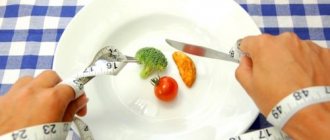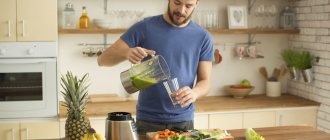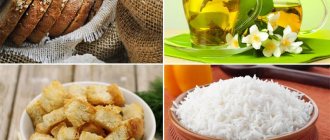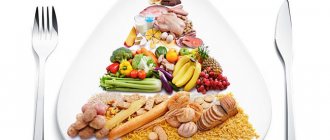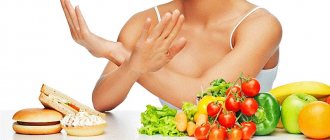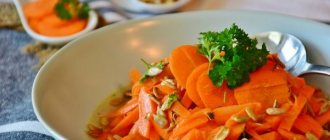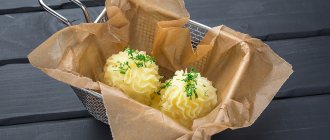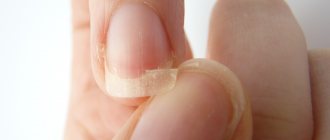Protein-free diet - is it safe for your health? We will learn in more detail how to create a menu for a week if you have kidney disease, what foods you can eat to lose weight in order to achieve minus 6 kg in 7 days. We look at the list of products and results. Go!
Hello friends! How realistic is it to lose weight on a protein-free diet? Such an important element is simply necessary as a building material for new cells. Detailed information about dietary nutrition will help you avoid possible mistakes in the process. Today we will talk about the basic principles, rules for creating a menu, contraindications and other important things.
Protein-free diet - basic rules
What does such a name mean? You must always remember that it is impossible to completely eliminate one of the important nutritional elements! In order not to harm your body, you should adhere to the following rules:
Friends, read the article further, there will be a lot of interesting things in it!
And for those who want:“DO YOU FIND OUT WHAT IS KEEPING YOU FROM LOSSING WEIGHT?”
Take the TEST .
- Protein is the basis of life! Such a vital element should not be completely excluded from the diet. The daily protein intake for an adult is 0.75 g per kilogram of weight. With such a diet, the optimal reduction is up to 0.55 g. Otherwise, your body will not be able to synthesize various amino acids.
- No physical activity. When protein intake is insufficient, the body begins to break down muscle structure to extract energy to support all systems. You should avoid intense sports activities.
- You need to reduce your consumption of water and salt. In case of renal failure, it is recommended to consume no more than 0.5-1 pure water without gas. Spices and salt should be completely excluded from the diet.
- Get rid of bad habits. No fatty, salty foods, flour or alcohol. Such habits can negatively affect the process of losing weight.
- Meals more than three times a day. To avoid feeling hungry, meals are divided into 5-6 meals. The bulk of calories should be consumed in the first half of the day. Last meal two hours before bedtime.
Protein-free diet - menu for 7 days
A protein-free diet consists of three main stages:
- Preparation. For three days we gradually remove protein from the diet.
- Main period. We follow the given program for a week.
- Smooth exit. Another week for the stomach to adapt to the previous food.
Once a week you should introduce a protein day and eat two eggs and drink a glass of milk with cheese. Otherwise, the processes of digestion and metabolism are disrupted. Sample menu for seven days:
- raw vegetables at any time;
- steamed vegetables, boiled potatoes;
- vegetable salads with apples and oranges;
- yogurt plus any unsweetened fruits and vegetables;
- one egg, vegetables and fruits;
- salads with herbs and a little sour cream.
If you feel hungry between main meals, you can eat fresh vegetables or fruits at any time. They contain more useful microelements than cooked ones.
Protein-free diet for the day
A similar menu can be used for a three-day or seven-day course for losing weight, no more. At first it is difficult to get used to different foods, but after a couple of days you will feel normal about the new diet. Patients with kidney disease are often prescribed the following regimen:
- Breakfast. 30 g of steamed oatmeal in water, a small piece of white bread, green tea with sugar.
- Lunch. Any fruits or vegetables.
- Dinner. Vegetable broth soup with cabbage salad, bread and a glass of juice;
- Afternoon snack. Two apples and an orange.
- Dinner. Fish cutlets with pasta or rice, tea with cookies.
- Before going to bed, drink a glass of milk.
The calorie content of all products is about 2000-2500 Kcal.
Menu (Power Mode)
Strict compliance with the requirements and calculation of the amount of protein, potassium and phosphorus makes it possible to improve the patient’s quality of life and extend the dialysis-free period. For calculations, patients use tables of protein, phosphorus and potassium content in foods.
Six grams of animal protein are contained in: one egg, 30 g of fish, 25 g of meat, 60 g of sour cream, 25 g of cheese, 150 g of yogurt and 25 g of seafood. Two grams of vegetable protein contain 120 g of potatoes, 150 g of oatmeal and 100 g of rice. To add flavor to food, you can use small amounts of dill, bay leaf, parsley, basil, cinnamon, onion, cloves or garlic. You can use low-protein products: amylopectin starch, sago, bread made from maize starch.
It is impossible to create a universal menu suitable for all patients, since the degree of azotemia and disturbances in phosphorus-potassium metabolism are different for everyone. When drawing up a menu, you need to base it on the doctor’s recommendation. An approximate menu for Table 7B might look like this:
| Breakfast |
|
| Lunch |
|
| Dinner |
|
| Afternoon snack |
|
| Dinner |
|
| For the night |
|
| Breakfast |
|
| Lunch |
|
| Dinner |
|
| Afternoon snack |
|
| Dinner |
|
| For the night |
|
| Breakfast |
|
| Lunch |
|
| Dinner |
|
| Afternoon snack |
|
| Dinner |
|
| For the night |
|
Weekly menu for kidney disease
If there are kidney stones or other similar problems, this method of nutrition will solve the problem in a short time without pain. Remember: the volume of water is no more than 0.5 per day. We focus on eating vegetables and fruits. Menu example:
- for breakfast we eat one egg and wash it down with milk;
- for lunch we make vegetable salad and stew;
- in the afternoon we eat any fruit (except forbidden ones);
- make a vegetable salad.
The course should not last more than 10 days, as this is unsafe for your health.
Fully or partially limited products
- Broths (fish, meat and mushroom).
- Animal fats.
- Salty products: canned food, cheeses, chips, sausages, sauces, ketchups, salted nuts, marinades, soup concentrates, bouillon cubes, margarine, salted butter.
- Potassium-containing foods: sorrel, bananas, coffee, milk powder, millet porridge, curry, fruit juices, fish, meat, chocolate, rhubarb, avocado, seeds, sesame, dried fruits, potatoes, many nuts (primarily almonds, peanuts, pine nuts) , peanut butter and paste, wine, beer, parsley, tomatoes (and products made from them - ketchup, sauce, juice), spinach, apple juice and syrup, beets, artichokes, soy products, soybeans, mushrooms, beans, lentils.
- Phosphorus-containing products: milk, cheeses, liver, kidneys, fish, fish caviar, chocolate, mushrooms, bran, nuts, seeds.
- Alcohol and carbonated drinks.
Table of prohibited products
| Proteins, g | Fats, g | Carbohydrates, g | Calories, kcal | |
Vegetables and greens | ||||
| vegetables legumes | 9,1 | 1,6 | 27,0 | 168 |
| sauerkraut | 1,8 | 0,1 | 4,4 | 19 |
| bulb onions | 1,4 | 0,0 | 10,4 | 41 |
| canned cucumbers | 2,8 | 0,0 | 1,3 | 16 |
| pickles | 0,8 | 0,1 | 1,7 | 11 |
| radish | 1,2 | 0,1 | 3,4 | 19 |
| white radish | 1,4 | 0,0 | 4,1 | 21 |
| turnip | 1,5 | 0,1 | 6,2 | 30 |
| tomatoes | 0,6 | 0,2 | 4,2 | 20 |
| canned tomatoes | 1,1 | 0,1 | 3,5 | 20 |
| spinach | 2,9 | 0,3 | 2,0 | 22 |
| sorrel | 1,5 | 0,3 | 2,9 | 19 |
Fruits | ||||
| apricots | 0,9 | 0,1 | 10,8 | 41 |
| bananas | 1,5 | 0,2 | 21,8 | 95 |
| figs | 0,7 | 0,2 | 13,7 | 49 |
| nectarine | 0,9 | 0,2 | 11,8 | 48 |
| peaches | 0,9 | 0,1 | 11,3 | 46 |
Mushrooms | ||||
| mushrooms | 3,5 | 2,0 | 2,5 | 30 |
| marinated mushrooms | 2,2 | 0,4 | 0,0 | 20 |
Nuts and dried fruits | ||||
| raisin | 2,9 | 0,6 | 66,0 | 264 |
| dried apricots | 5,2 | 0,3 | 51,0 | 215 |
| dried apricots | 5,0 | 0,4 | 50,6 | 213 |
| dates | 2,5 | 0,5 | 69,2 | 274 |
Cereals and porridges | ||||
| semolina | 10,3 | 1,0 | 73,3 | 328 |
| cereals | 11,9 | 7,2 | 69,3 | 366 |
| corn grits | 8,3 | 1,2 | 75,0 | 337 |
| pearl barley | 9,3 | 1,1 | 73,7 | 320 |
| millet cereal | 11,5 | 3,3 | 69,3 | 348 |
Flour and pasta | ||||
| pasta | 10,4 | 1,1 | 69,7 | 337 |
Chocolate | ||||
| chocolate | 5,4 | 35,3 | 56,5 | 544 |
Raw materials and seasonings | ||||
| ginger | 1,8 | 0,8 | 15,8 | 80 |
| ketchup | 1,8 | 1,0 | 22,2 | 93 |
| mayonnaise | 2,4 | 67,0 | 3,9 | 627 |
| tomato sauce | 1,7 | 7,8 | 4,5 | 80 |
Meat products | ||||
| pork | 16,0 | 21,6 | 0,0 | 259 |
| salo | 2,4 | 89,0 | 0,0 | 797 |
Bird | ||||
| smoked chicken | 27,5 | 8,2 | 0,0 | 184 |
| duck | 16,5 | 61,2 | 0,0 | 346 |
| smoked duck | 19,0 | 28,4 | 0,0 | 337 |
| goose | 16,1 | 33,3 | 0,0 | 364 |
Fish and seafood | ||||
| dried fish | 17,5 | 4,6 | 0,0 | 139 |
| smoked fish | 26,8 | 9,9 | 0,0 | 196 |
| black caviar | 28,0 | 9,7 | 0,0 | 203 |
| salmon caviar granular | 32,0 | 15,0 | 0,0 | 263 |
| canned fish | 17,5 | 2,0 | 0,0 | 88 |
Oils and fats | ||||
| animal fat | 0,0 | 99,7 | 0,0 | 897 |
| cooking fat | 0,0 | 99,7 | 0,0 | 897 |
Juices and compotes | ||||
| tomato juice | 1,1 | 0,2 | 3,8 | 21 |
* data is per 100 g of product
Protein-free diet for diabetics
This diet is aimed at normalizing blood sugar levels. It is recommended to use it no more than once a month. We exclude eggs, spices and sugar. The menu is as follows:
- cabbage salad or zucchini caviar with green tea;
- fresh cucumbers or tomatoes;
- cook pasta without spices, eat it with salad and unsweetened compote;
- light fruit salad;
- some white rice and grated beets.
Recipes
To make your diet more gentle and enjoyable, you can include the following dishes:
- Vegetarian borscht. The beets need to be peeled and boiled until half cooked. Then you need to grate it on a fine grater. Chopped carrots, tomatoes and onions must be stewed in oil (vegetable). Soaked potatoes are placed in the beet broth, boiled for 15–17 minutes, after which cabbage is added to it, and after 2–4 minutes, stewed vegetables are added. To season the dish, you can use sour cream or herbs.
- Rice and sago porridge. The ingredients must be taken in equal proportions and filled with water, then placed on the gas stove. Boil the mixture over low heat for 45 minutes. 250 ml of fresh milk and granulated sugar are added to the prepared gruel, after which the dish is brought to a boil. The dish should be served with butter.
- Meat and sago. You need to take ready-made porridge or prepare 1 serving of sago. The product is heated in a water bath. At this time, you need to boil the beef. After this, 50 g of boiled meat is taken, ground in a meat grinder, fried a little with the addition of onions and added to the sago.
- Potato zrazy with cabbage added. The potatoes are peeled, cut into small pieces and soaked for 60–70 minutes. Then the product must be boiled, cooled and crushed. At this time, you can stew the white cabbage with the addition of dill, pepper and bay leaf. You need to form a flat cake from mashed potatoes and place it on the minced cabbage. Then it must be fried using vegetable oil. It is recommended to serve the dish with natural sour cream.
- Carrot cutlets. You need to peel and boil the carrots. The cooled product should be crushed using a grater and 2 tbsp added to the resulting mixture. l. semolina and sugar. Then the mixture is stirred and infused until the cereal swells. After this, you need to make small cutlets from it and fry them in vegetable oil.
What foods can you eat - list
Thanks to this list, you can create your own daily menu, deciding what is ok and what is best left aside. List of products recommended for consumption:
- flakes, cereals (need to be steamed);
- raw or cooked vegetables (single boiled potatoes);
- fruit to taste;
- bread in small quantities;
- oil;
- low-fat fermented milk products in small quantities;
- dried fruit compote, fruit juice, green tea.
Prohibited products - list
You should refrain from:
- pumpkin, watermelon and sweet melon;
- margarine;
- from any type of meat, fish or poultry;
- eggs, cottage cheese or cheese;
- spices, garlic or hot pepper;
- sweet buns and sweets;
- carbonated drinks and strong coffee;
- nuts or sunflower seeds;
- soy food and mushrooms.
It is recommended that you consult your doctor first about menu restrictions. He will create a correct and healthy diet that will effectively support the body.
“Basal Metabolism: Your Four Secret Numbers on the Path to Weight Loss”
Friends!
I, Andrey Eroshkin, will conduct mega interesting webinars for you, sign up and watch! Topics of upcoming webinars:
- How to lose weight without willpower and prevent the weight from coming back?
- How to become healthy again without pills, the natural way?
- Where do kidney stones come from and what can be done to prevent them from appearing again?
- How to stop visiting gynecologists, give birth to a healthy child and not grow old at 40?
SIGN UP FOR THE WEBINAR
Who needs a protein-free diet?
As a rule, this type of diet is used in cases of serious kidney damage. In this case, patients are on strict bed rest and drink a small amount of water.
The second reason is the presence of problems with the removal of proteins from the body. Then a similar treatment is prescribed to help the body. It is not recommended for healthy people to get carried away with such nutrition - protein is essential for us! Weight loss down to minus 6 kg in 7 days is achieved through a low-calorie menu. However, the result obtained is temporary and harmful to you.
Protein free nutrition concept
If we talk about the presence of kidney disease in a person, then the menu in this case should include products whose total calorie content reaches 2200 kcal per day. This indicator can be lowered if proper bed rest is observed or the person is initially light in weight. The main rule of following a protein-free diet is to limit protein foods in food. The daily intake with this approach should not exceed 20 grams of proteins.
Plant products come to the fore in this food system. Therefore, it is quite logical to prohibit the consumption of such foods as:
- Fish;
- Eggs;
- Some dairy products;
- Meat.
As for fats and carbohydrates, the daily intake of fats per day should not exceed 80 grams, carbohydrates - 350 grams.
A protein-free diet for weight loss has one important condition, which manifests itself in limited fluid intake. This is because the affected kidneys cannot handle a large volume of water, so the amount of fluid consumed should be less than or equal to the amount of urine produced. An ordinary person, as a rule, excretes 250 ml of fluid per day; in a patient, these figures may be slightly higher. This does not mean that you can drink just one glass of water throughout the day.
The concept of such nutrition assumes that the fluid in a sick person should be reduced by half than in a healthy person. For example, if on other types of diets people are advised to drink at least 2-2.5 liters of water per day, then on a diet without proteins, people with kidney problems should not exceed a liter of fluid per day.
results
First of all, it should be understood that this course was created for patients with kidney disease. Most often it is used to relieve protein metabolism or for renal failure. The method will only bring temporary weight loss by removing excess water from the body. The results of such a week-long course will be:
- the lack of protein is reflected on the surface of the skin, it loses its elasticity and becomes dry;
- hair and nails become thin and brittle;
- cells are poorly restored;
- metabolism slows down;
- fatigue and irritation appear;
- the sleep cycle is disrupted.
Such a stress load will lead to a deterioration in general condition, but not to the desired weight loss. How to achieve your goal safely?
Body Mass Index Calculator
Additional recommendations
At the initial stage of kidney damage, the amount of protein consumed should be calculated at 800 mg/kg body weight. It is better to replace ordinary bread with a product that lacks protein. At this stage, patients do not need to take medications that contain amino acids.
In case of stage 2 renal failure, the amount of protein consumed should be limited to 400–500 mg per 1 kg of body weight.
To reduce the concentration of phosphates, products must be thoroughly boiled. It could be rice, potatoes or fish. To compensate for amino acid deficiency, special drugs are prescribed (for example, Ketosteril).
At stage 3 chronic renal failure, the amount of protein is calculated at 300 g/kg body weight. In this case, the patient is additionally prescribed amino acid preparations.
In conditions of minimal protein intake into the body, it is necessary to carefully monitor the nitrogen balance and limit the amount of potassium consumed (potatoes, raisins, dried apricots, etc.).
